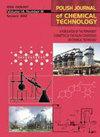Kinetic of Oil Sludge Thermolysis Process in Presence of Nickel, Cobalt and Iron-Supported Microsilicate
IF 1
4区 工程技术
Q4 CHEMISTRY, APPLIED
引用次数: 0
Abstract
Abstract The article is devoted to the experimental determination of thermokinetic parameters of oil sludge thermal degradation using the model-free Ozawa-Flynn-Wall method in the presence of a nanocatalyst (nickel, cobalt and iron-supported microsilicate) by calculating Arrhenius kinetic parameters (activation energy and pre-exponential factor). The phase composition of the reflex microsilicate was established – 4.12; 2.51 Å – SiO 2 , nickel-supported microsilicate reflexes: 2.09; 1.48 Å – NiO, reflexes: 4.25 Å – SiO 2 and acid numbers of microsilicate – 64 μmol/g of prepared nanocatalysts. Using the method of Brunauer, Emmett and Teller, the specific surface area of the microsilicate was established – 18.3 ± 0.3 m 2 /g, the microsilicate with nickel applied – 20.9 ± 0.2 m 2 /g and the adsorption isotherm of the prepared nanocatalysts (microsilicate with nickel, cobalt and iron). Thermokinetic parameters of thermal decomposition of oil sludge without a catalyst and with a catalyst at an increment of 0.9 are 99.0 and 93.3 kJ/mol nickel-supported microsilicate, 51.9 kJ/mol cobalt-supported microsilicate, 111.3 kJ/mol iron-supported microsilicate and non-metal-supported microsilicate 173.7 kJ/mol, respectively. The study of the kinetic parameters of pyrolysis of oil sludge using various catalysts makes it possible to assess their influence on the process of decomposition of organic components. The results of the experiments showed that the use of catalysts significantly affects the destruction of oil sludge. Dynamic thermal analysis at different heating rates studied the dynamics of oil sludge decomposition. The study of the effect of catalysts on the kinetic parameters of oil sludge pyrolysis is an important step in the development of new methods for the disposal of petroleum products and the reduction of their negative impact on the environment. The obtained experimental data on thermal degradation kinetics of oil sludge will find application in designing a reactor for the process of destructive hydrogenation of heavy hydrocarbon raw materials.镍、钴和铁负载微硅酸盐存在下油泥热裂解动力学研究
本文通过计算Arrhenius动力学参数(活化能和指前因子),研究了纳米催化剂(镍、钴和铁负载的微硅酸盐)存在下,采用无模型Ozawa-Flynn-Wall法测定油泥热降解的热力学参数。建立了反射微硅酸盐的相组成- 4.12;2.51 Å -二氧化硅,镍负载微硅酸盐反射:2.09;1.48 Å - NiO,反射性:4.25 Å - sio2和微硅酸盐酸数-制备的纳米催化剂64 μmol/g。采用Brunauer, Emmett和Teller的方法,确定了微硅酸盐的比表面积为- 18.3±0.3 m2 /g,镀镍微硅酸盐的比表面积为- 20.9±0.2 m2 /g,以及所制备的纳米催化剂(镍、钴和铁微硅酸盐)的吸附等温线。无催化剂和催化剂添加量为0.9时油泥热分解的热力学参数分别为:镍微硅酸盐为99.0和93.3 kJ/mol,钴微硅酸盐为51.9 kJ/mol,铁微硅酸盐为111.3 kJ/mol,非金属微硅酸盐为173.7 kJ/mol。通过研究不同催化剂对油泥热解的动力学参数,可以评估其对有机组分分解过程的影响。实验结果表明,催化剂的使用对油泥的破坏有显著影响。动态热分析研究了不同升温速率下油泥分解的动力学过程。研究催化剂对油泥热解动力学参数的影响是开发石油产品处置新方法和减少其对环境的负面影响的重要一步。所获得的油泥热降解动力学实验数据将在重烃原料破坏性加氢工艺反应器的设计中得到应用。
本文章由计算机程序翻译,如有差异,请以英文原文为准。
求助全文
约1分钟内获得全文
求助全文
来源期刊

Polish Journal of Chemical Technology
CHEMISTRY, APPLIED-ENGINEERING, CHEMICAL
CiteScore
1.70
自引率
10.00%
发文量
22
审稿时长
4.5 months
期刊介绍:
Polish Journal of Chemical Technology is a peer-reviewed, international journal devoted to fundamental and applied chemistry, as well as chemical engineering and biotechnology research. It has a very broad scope but favors interdisciplinary research that bring chemical technology together with other disciplines. All authors receive very fast and comprehensive peer-review. Additionally, every published article is promoted to researchers working in the same field.
 求助内容:
求助内容: 应助结果提醒方式:
应助结果提醒方式:


